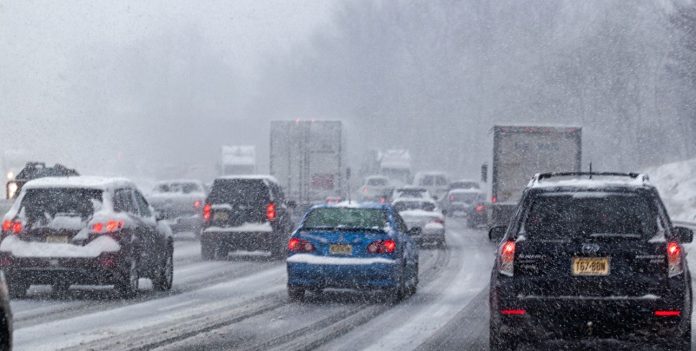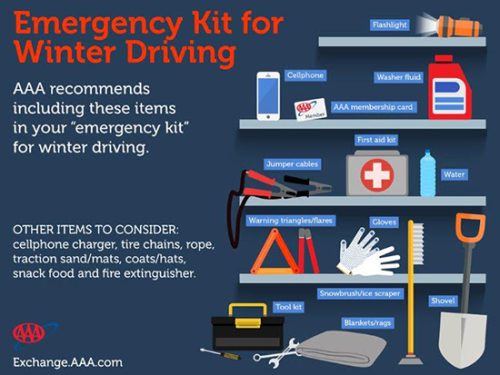As winter weather is in the forecast for the North East and we near the one year anniversary of Virginia’s I-95 shutdown that left motorists stranded along 50 miles of frozen roadway, AAA reminds drivers of how important it is to be prepared before the harsh winter weather hits.
It was back on January 2, 2022, that drivers were left stranded in their vehicles on Interstate 95 for more than 24 hours as a snowstorm moved through the region. Some drivers ran out of gas, others conserved fuel by cycling their vehicles on and off to stay warm. Those trapped in the massive backup became keenly aware of what they had in their vehicles to help sustain them through the long, chilly hours on the interstate.
“Whether it’s a trip to the mountains for a ski weekend or a drive across town to try out a new restaurant, drivers need to be prepared for any possibility,” says Tracy Noble, Manager for Public and Government Affairs for AAA Mid-Atlantic. “While the shutdown on I-95 is an extreme example, hours-long delays on winter roadways are not unusual, especially at higher elevations and on more rural roadways that regularly see sleet, snow and ice during the winter months.”
It doesn’t take much in the way of snow or ice to cause issues on the roads. AAA warns travelers to “know before you go.” If you have to be on the roads during a storm event, check weather and travel conditions along your route before heading out. Flex your travel schedule and route accordingly as forecasts and road conditions can change quickly.
AAA also reminds drivers that careful preparations now can make a huge difference down the road during a delay. A well-stocked emergency kit and can be an invaluable go-to resource if you’re stranded. Those trapped in the I-95 shutdown who had a fully stocked emergency kit were in better shape than those who didn’t have any emergency supplies with them. The kit should include items to help if your vehicle becomes stuck or breaks down, and items to help you and your passengers “weather” the delay.
- Abrasive material (sand, salt, cat litter) or traction mats
- Snow shovel
- Flashlight with extra batteries
- Window washer solvent
- Ice scraper with brush,
- Jumper cables
- Extra warm clothing (gloves, hats, scarves), and blankets
- Warning devices (flares or triangles)
- Drinking water and non-perishable snacks for both human and pet passengers
- First-aid kit
- Basic toolkit (screwdrivers, pliers, adjustable wrench)
- Mobile phone, charger and power bank
“Before you hit the road, make sure everyone in the vehicle is dressed for the weather outside, not for the temperature they’re hoping the heat will be set to inside the car,” added Noble. Remember, children should not be strapped into a car seat wearing a heavy coat as the extra layer can allow the child to move around too much under the straps a crash. Remove the coat, strap the child in, and then use the coat as a blanket on top of them if they are cold.
AAA advises to be cautious when driving in winter conditions and offers the following safety tips:
- Slow down. Adjust your speed to the road conditions and leave yourself ample room to stop. Allow at least three times more space than usual between you and the car in front of you. Accelerate, turn and brake gradually. Don’t brake and turn at the same time. Asking the car to do two things at once makes it more likely your tires will lose traction.
- Never use cruise control on slippery roads. A driver should always be in full control of their vehicle during poor road conditions and cruise control can misinterpret slipping and sliding as the vehicle slowing down and attempt to accelerate to maintain speed.
- Avoid unnecessary lane changes. Changing lanes increases the chances of hitting a patch of ice between lanes that could cause loss of vehicle traction. Drive in plowed lanes. If that’s not available, drive in the tire tracks of vehicles in front of you.
- Do not power up hills. Applying extra gas on snow-covered roads may only result in spinning your wheels. Try to get a little inertia going before you reach the hill and let that inertia carry you to the top. As you reach the crest of the hill, reduce your speed and proceed downhill as slowly as possible. Don’t stop on a hill as you may not be able to get the vehicle moving again.
- Control the skid. Slamming on the brakes can make the skid even worse. In the event of a skid, take your foot off the brake or accelerator, continue to look and steer where you want to go. Then begin to accelerate slowly.
If your vehicle does become stuck in the snow or ice:
- Stay with your vehicle. It provides temporary shelter and makes it easier for rescuers to locate you.
- Do not try to walk in a severe storm. It is easy to lose sight of your vehicle and get lost in blowing snow.
- Do not overexert yourself trying to dig or push your vehicle out of the snow. Keep sand, kitty litter or traction mats in your vehicle to help the vehicle’s tires gain traction on ice and snow. Even a vehicle’s floor mats can help in a jam.
- Tie a brightly colored cloth to the antenna or place a cloth at the top of a rolled up window to signal distress.
- Make sure the exhaust pipe is not clogged with snow, ice or mud. A blocked exhaust pipe could cause deadly carbon monoxide gas to leak into the vehicle when the engine is running.
- If possible, run the engine and heater just long enough to remove the chill and to conserve gasoline.


